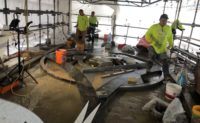It seems a distant memory as we move into the heat of summer, but just a few months ago roof collapses were making headlines as never before. Massive accumulations of snow crushed everything from the Minneapolis Metrodome to schools, homes and churches. Media coverage stoked worries about structural integrity and whether building codes were sufficient for the extreme storms of a changing climate.
Last winter saw major facility owners taking preventative actions to avoid dangerous roof collapses. After conducting an evaluation with the help of structural engineers, the operators of the MassMutual Center, Springfield, Mass., for example, canceled some events amid mounting concern about the center's snow-packed roof.
Despite the news and increased concerns, especially in the Northeast, no hard data has yet been presented to convince us that the winter storms that blanketed the U.S. were beyond the level of severity contemplated by current building regulations. Future research about these storms may turn up new information.
But since property owners are now more knowledgeable and cautious about the risk of roof collapses, it is very important that engineers, architects and contractors consider unusual snow loads when revising their ongoing risk management procedures, especially as heavy snows in the most populated regions revealed weaknesses in roof design and construction that had been concealed by milder, less snowy winters.
Current codes call for building designs to accommodate the snow loads of one-in-50-year events; the design industry typically goes that distance and then some, requiring that roof structures are at least 60% stronger than the effects of the 50-year snow event. Codes also require consideration of drifting, sliding and melting snow based on the roof configuration and insulation.
Designing to code is one thing, but you don't have to be wrong to be sued. Very often the lawsuit is triggered by something beyond the control of a design professional.
Gary Klein, senior principal of engineer Wiss Janney Elstner Associates, agrees that designers rarely fail to meet code or make outright design errors that lead to problems. More often, the problem arises from the process, such as a change introduced during value-engineering by the owner or poor quality control of a manufactured roof system. That roof system may have been designed by a third party, rather than an engineer-of-record.
All-Season Risk Management
These events underscore the importance of rigorous adherence to risk management practices in all seasons. Sound practices avoid claims and put firms in the best position to defend themselves in case legal claims are made.
• Stay within your area of expertise, including your area of geographic expertise. For example, if you typically design condominiums along the Florida coast, ensure you have the experience or can tap the expertise of a consultant before accepting projects far away in, say, the mountains of Colorado.


Post a comment to this article
Report Abusive Comment